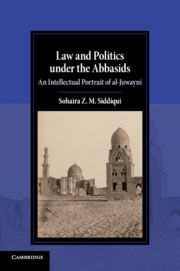Book contents
- Law and Politics under the Abbasids
- Cambridge Studies in Islamic Civilization
- Law and Politics under the Abbasids
- Copyright page
- Dedication
- Contents
- Acknowledgments
- Introduction
- Part I Historical Background
- Part II Epistemology
- Part III Legal Theory
- Part IV Political Thought
- Conclusion
- Bibliography
- Index
- Series page
- References
Bibliography
Published online by Cambridge University Press: 08 April 2019
- Law and Politics under the Abbasids
- Cambridge Studies in Islamic Civilization
- Law and Politics under the Abbasids
- Copyright page
- Dedication
- Contents
- Acknowledgments
- Introduction
- Part I Historical Background
- Part II Epistemology
- Part III Legal Theory
- Part IV Political Thought
- Conclusion
- Bibliography
- Index
- Series page
- References
Summary

- Type
- Chapter
- Information
- Law and Politics under the AbbasidsAn Intellectual Portrait of al-Juwayni, pp. 291 - 306Publisher: Cambridge University PressPrint publication year: 2019

